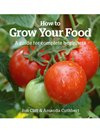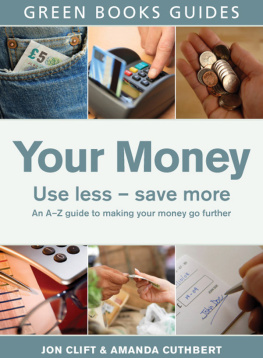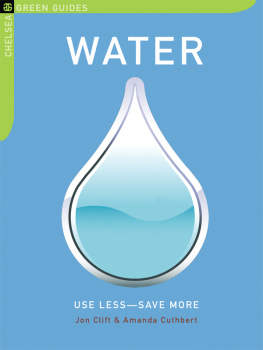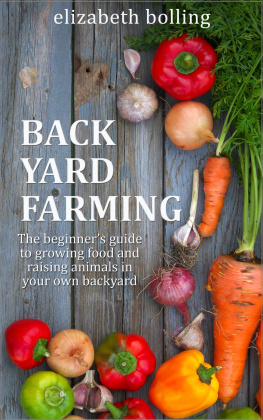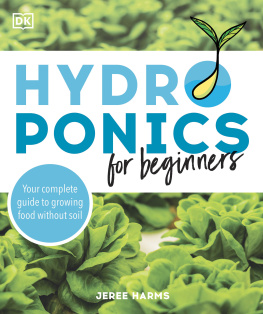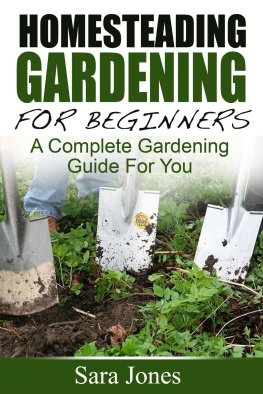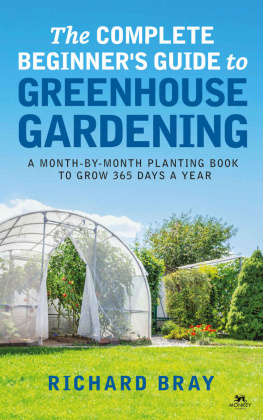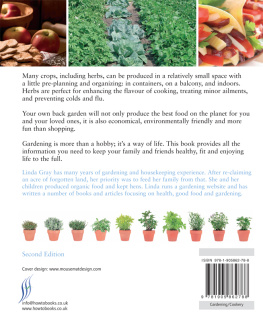Jon Clift - How to grow your food : a guide for complete beginners
Here you can read online Jon Clift - How to grow your food : a guide for complete beginners full text of the book (entire story) in english for free. Download pdf and epub, get meaning, cover and reviews about this ebook. City: Totnes, year: 2011, publisher: Green Books, genre: Children. Description of the work, (preface) as well as reviews are available. Best literature library LitArk.com created for fans of good reading and offers a wide selection of genres:
Romance novel
Science fiction
Adventure
Detective
Science
History
Home and family
Prose
Art
Politics
Computer
Non-fiction
Religion
Business
Children
Humor
Choose a favorite category and find really read worthwhile books. Enjoy immersion in the world of imagination, feel the emotions of the characters or learn something new for yourself, make an fascinating discovery.
- Book:How to grow your food : a guide for complete beginners
- Author:
- Publisher:Green Books
- Genre:
- Year:2011
- City:Totnes
- Rating:4 / 5
- Favourites:Add to favourites
- Your mark:
- 80
- 1
- 2
- 3
- 4
- 5
How to grow your food : a guide for complete beginners: summary, description and annotation
We offer to read an annotation, description, summary or preface (depends on what the author of the book "How to grow your food : a guide for complete beginners" wrote himself). If you haven't found the necessary information about the book — write in the comments, we will try to find it.
Jon Clift: author's other books
Who wrote How to grow your food : a guide for complete beginners? Find out the surname, the name of the author of the book and a list of all author's works by series.
How to grow your food : a guide for complete beginners — read online for free the complete book (whole text) full work
Below is the text of the book, divided by pages. System saving the place of the last page read, allows you to conveniently read the book "How to grow your food : a guide for complete beginners" online for free, without having to search again every time where you left off. Put a bookmark, and you can go to the page where you finished reading at any time.
Font size:
Interval:
Bookmark:
How to
A guide for complete beginners


First published in 2011 by
Green Books
Dartington Space, Dartington Hall, Totnes, Devon TQ9 6EN
2011 Jon Clift & Amanda Cuthbert
All rights reserved
No part of this book may be used or reproduced in any manner without written permission, except in the case of brief quotations in critical articles or reviews.
Design by Jayne Jones
Illustrations by Emily Barden
Print edition ISBN 978 1 900322 68 3
PDF format ISBN 978 0 85784 080 6
ePub format ISBN 978 0 85784 081 3

Theres nothing like the taste of fruit and vegetables you have grown yourself. The flavour beats anything you will get from a supermarket and the health benefits of fresh produce that has not been stored and transported for miles, or sprayed with chemicals, are obvious. Even if you only have a windowsill or some hanging baskets you will be surprised how much you can grow maybe theres room on a sunny stairwell or by the car park? Or if youve got a lawn, perhaps you dont need it? Grow food instead! Its fun to grow your own organic food and it saves you a lot of money.
This book will get you started: we have chosen fruit, vegetables and herbs that are easy to grow. Radishes, for example, can be grown almost anywhere in any space, are quick to give results and are relatively trouble-free compared with, say, asparagus or cauliflowers, which need more looking after and patience. There are literally hundreds of different varieties of seed available, from the tried-and-tested to the more unusual in this book weve suggested some varieties to get you going.
It is very rewarding to eat something that you have nurtured from a tiny seed, but if you dont have much time or space you can take a short cut many vegetables can now be bought as young plants. Where relevant we have included advice for both growing from seed and growing from a small plant that you have either raised yourself or bought.
Happy growing!


Space
How much space have you got? Even a tiny balcony or south-facing windowsill can be a space for growing food. Be creative you can grow plants in pots, bags, boxes or even milk cartons. If youve only got flowerbeds, why not grow a few runner beans, some sweetcorn or a courgette or two in amongst the flowers? Herbs are really easy in containers, and as they dont need much water they also do well on sunny banks. If you have a small strip of earth by a south-facing wall (maybe down the side of a path?) grow some tomatoes theyll like the heat from the wall. If youve just got concrete, you can grow in containers or raised beds. Whatever your space, you can grow something.
Position
Light: Youll need to think about light and shade before deciding what to grow. Most plants benefit from sunshine, so a north-facing balcony could be difficult, but maybe you have a sunny windowsill? If you have a garden, where are the sunny spots that are going to be best for growing your sun-loving vegetables? The more sun the plants get in the growing season the quicker and more productively they will grow.
Shelter: If possible, try to make sure that at least part of your growing area is out of the wind strong winds and heavy rain can damage young plants, especially tall ones.
Weather
Be aware of the seasons where you live you may need to adapt your growing to suit your local climate. If you live in a colder part of the country you will need to plant a bit later than if you live in the warmer south (use the later dates recommended in this book). Likewise, if you have a drier climate you will need to think about growing crops that dont mind dry conditions, or be prepared to get out there frequently with the watering can.
Soil
What kind of soil do you have? If it is thick, heavy, clay soil it is a good idea to add some compost (see ) to try to open it up and make it less dense. If it is a light, sandy soil add well-rotted farm manure, if you can get hold of some, or compost, which will help give the soil more body and reduce water loss. Compost both adds nutrients and enriches your soil, which will mean healthier plants.
If you are growing in containers or a window box you will need a good growing compost; there are lots of different sorts on offer, but buy compost that is peat-free (lets save what peat bogs still remain!) and, ideally, organic if you can.
Water
Its a good idea to invest in some water butts to catch the free water from the roof of your house or shed; you cant have too much, especially in a dry summer. If you are running a tap in the kitchen waiting for your water to warm up, rather than waste it, collect the cold water into a bucket and save it to use it on your plants.
Equipment
You can get by with very little equipment or, in some cases, can make your own.
Tools: If you are growing indoors you can make do with an old spoon, although a trowel is handy. Outdoors you can manage with a trowel and a large fork, but a spade, hoe and rake are also useful. Garage sales are great places to find cheap tools.
Watering: A large watering can for outside; a small one or a jug for inside.
Labelling: Plant labels can be made from cut-up yoghurt pots; use a permanent marker or soft pencil.
Tying in or up: A pair of scissors and something to tie plants up with string, thin strips of old rag, etc.
Pruning: Secateurs.
Support: Sticks, canes, trellis or netting.
Protection: Net and fleece will help to protect plants from pests and cold weather. Cloches (see ) are useful both for warmth and to give protection from pests; you can make your own small cloche by cutting a large plastic water bottle in half.

Tools dont have to be new.
Containers
While you can spend a lot of money on different sorts of container, you can also find or make things to sow and grow in that cost next to nothing.
Pots and modules: There are many different kinds of container for sowing seeds in from seed trays and modules to pots of different shapes and sizes. You can also use yoghurt pots or fruit juice cartons (with a small hole made in the bottom), or plastic containers from supermarket-packaged fruit and vegetables.

Young seedlings.
Raised beds: You can make your own or buy ready-made ones, which are made from wood or recycled plastic, are easy to use and can be placed on solid surfaces, like concrete or gravel, or on grass or soil.
Old builders bags: Great for larger crops such as runner beans or sweetcorn; they will need holes in the bottom for drainage.
Next pageFont size:
Interval:
Bookmark:
Similar books «How to grow your food : a guide for complete beginners»
Look at similar books to How to grow your food : a guide for complete beginners. We have selected literature similar in name and meaning in the hope of providing readers with more options to find new, interesting, not yet read works.
Discussion, reviews of the book How to grow your food : a guide for complete beginners and just readers' own opinions. Leave your comments, write what you think about the work, its meaning or the main characters. Specify what exactly you liked and what you didn't like, and why you think so.

